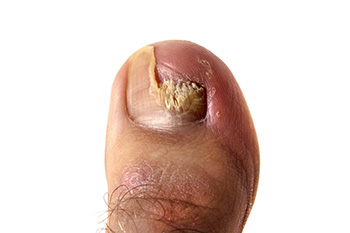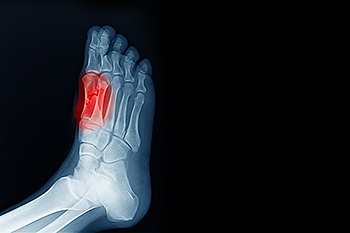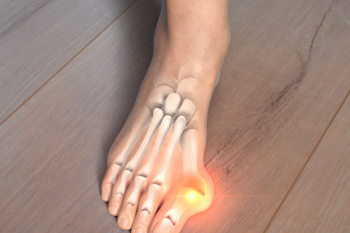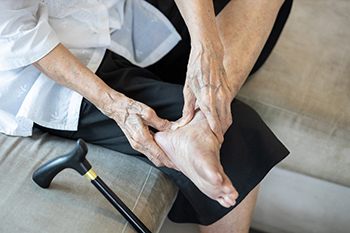
A disappearing nail bed, or DNB, is a rare condition where the nail plate begins to shrink or detach from the nail bed, often leading to nail loss or deformation. DNB can be caused by trauma, fungal infections, poor circulation, or certain skin conditions like psoriasis. It is more common in people with underlying health issues, such as diabetes or autoimmune disorders. The symptoms of DNB include pain or discomfort surrounding he nail, thinning or ridged nails, and a visible gap between the nail and nail bed. The area may look discolored or flaky, and in severe cases, the nail may fall off completely. Treatment for DNB focuses on addressing the underlying cause. A podiatrist may recommend topical treatments, proper nail care, or antibiotics if an infection is present. If the condition is caused by trauma or circulation issues, they may discuss ways to promote healing and prevent further nail loss. If you are experiencing changes in your nails, it is suggested that you schedule an appointment with a podiatrist to get an accurate diagnosis and effective treatment.
Ingrown toenails may initially present themselves as a minor discomfort, but they may progress into an infection in the skin without proper treatment. For more information about ingrown toenails, contact one of our podiatrists of Lovely Foot Associates, PC. Our doctors can provide the care you need to keep you pain-free and on your feet.
Ingrown Toenails
Ingrown toenails are caused when the corner or side of a toenail grows into the soft flesh surrounding it. They often result in redness, swelling, pain, and in some cases, infection. This condition typically affects the big toe and may recur if it is not treated properly.
Causes
You are more likely to develop an ingrown toenail if you are obese, have diabetes, arthritis, or have any fungal infection in your nails. Additionally, people who have foot or toe deformities are at a higher risk of developing an ingrown toenail.
Symptoms
Some symptoms of ingrown toenails are redness, swelling, and pain. In rare cases, there may be a yellowish drainage coming from the nail.
Treatment
Ignoring an ingrown toenail can have serious complications. Infections of the nail border can progress to a deeper soft-tissue infection, which can then turn into a bone infection. You should always speak with your podiatrist if you suspect you have an ingrown toenail, especially if you have diabetes or poor circulation.
If you have any questions, please feel free to contact our office located in Johnstown, PA . We offer the newest diagnostic and treatment technologies for all your foot care needs.

Sesamoiditis is an inflammation of the sesamoid bones, which are two small bones located beneath the big toe joint. These bones help in the movement and support of the toe, bearing a significant amount of pressure during walking, running, and other activities. The condition typically occurs due to overuse or repetitive stress on the feet. High-impact activities, improper footwear, or abnormal foot mechanics can contribute to the development of sesamoiditis. Common symptoms include pain and swelling around the base of the big toe, especially when putting pressure on the affected area. The pain may worsen during physical activity or after long periods of standing or walking. People with sesamoiditis may also experience difficulty bending the toe or walking comfortably. If you have pain in this area of your foot, it is suggested that you consult a podiatrist who can provide an accurate diagnosis and treatment.
Sesamoiditis is an unpleasant foot condition characterized by pain in the balls of the feet. If you think you’re struggling with sesamoiditis, contact one of our podiatrists of Lovely Foot Associates, PC. Our doctors will treat your condition thoroughly and effectively.
Sesamoiditis
Sesamoiditis is a condition of the foot that affects the ball of the foot. It is more common in younger people than it is in older people. It can also occur with people who have begun a new exercise program, since their bodies are adjusting to the new physical regimen. Pain may also be caused by the inflammation of tendons surrounding the bones. It is important to seek treatment in its early stages because if you ignore the pain, this condition can lead to more serious problems such as severe irritation and bone fractures.
Causes of Sesamoiditis
Treatment for sesamoiditis is non-invasive and simple. Doctors may recommend a strict rest period where the patient forgoes most physical activity. This will help give the patient time to heal their feet through limited activity. For serious cases, it is best to speak with your doctor to determine a treatment option that will help your specific needs.
If you have any questions please feel free to contact our office located in Johnstown, PA . We offer the newest diagnostic and treatment technologies for all your foot and ankle needs.

A bunion, also known as hallux valgus, is a bony bump that forms at the base of the big toe. It occurs when the big toe moves toward the second toe, causing the joint to protrude and become misaligned. This misalignment can lead to pain, swelling, and redness around the affected area, making it difficult to wear certain shoes. Bunion formation is often gradual, and the condition can worsen over time without treatment. There are several risk factors that increase the likelihood of developing a bunion, including a family history of the condition, wearing tight or ill-fitting shoes, and certain foot deformities. Additionally, women are more prone to bunions than men, likely due to the frequent wearing of high heels. Bunions can also develop as a result of arthritis or other medical conditions that affect the joints. If left untreated, bunions can cause difficulty walking and further joint damage.If you have any of the above symptoms, it is suggested that you consult a podiatrist who can accurately diagnose and offer effective treatment solutions for bunions.
If you are suffering from bunions, contact one of our podiatrists of Lovely Foot Associates, PC. Our doctors can provide the care you need to keep you pain-free and on your feet.
What Is a Bunion?
A bunion is formed of swollen tissue or an enlargement of boney growth, usually located at the base joint of the toe that connects to the foot. The swelling occurs due to the bones in the big toe shifting inward, which impacts the other toes of the foot. This causes the area around the base of the big toe to become inflamed and painful.
Why Do Bunions Form?
Genetics – Susceptibility to bunions are often hereditary
Stress on the feet – Poorly fitted and uncomfortable footwear that places stress on feet, such as heels, can worsen existing bunions
How Are Bunions Diagnosed?
Doctors often perform two tests – blood tests and x-rays – when trying to diagnose bunions, especially in the early stages of development. Blood tests help determine if the foot pain is being caused by something else, such as arthritis, while x-rays provide a clear picture of your bone structure to your doctor.
How Are Bunions Treated?
If you have any questions, please feel free to contact our office located in Johnstown, PA . We offer the newest diagnostic and treatment technologies for all your foot care needs.

As individuals age, several changes occur in the feet that can lead to discomfort and mobility issues. One common change is dry skin, which becomes more prominent as the skin loses moisture and elasticity with age. This can lead to cracking and irritation. Another effect is the shortening of the Achilles tendon, which can cause tightness in the back of the ankle and difficulty walking or climbing stairs. Aging can also contribute to the development of flat feet, as the arches may collapse over time, leading to pain and instability. Hammertoe, a condition where the toes become bent at an abnormal angle, often develops due to muscle imbalances and changes in foot structure. Additionally, toenails may become thicker, more brittle, or discolored as blood circulation decreases and overall foot health declines. If you are elderly and have developed any of the above symptoms, it is suggested that you consult a podiatrist who can treat various foot conditions, and offer you an effective foot care routine.
Proper foot care is something many older adults forget to consider. If you have any concerns about your feet and ankles, contact one of our podiatrists from Lovely Foot Associates, PC. Our doctors can provide the care you need to keep you pain-free and on your feet.
The Elderly and Their Feet
As we age we start to notice many changes in our body, but the elder population may not notice them right away. Medical conditions may prevent the elderly to take notice of their foot health right away. Poor vision is a lead contributor to not taking action for the elderly.
Common Conditions
Susceptible Infections
Diabetes and poor circulation can cause general loss of sensitivity over the years, turning a simple cut into a serious issue.
If you have any questions please feel free to contact our office located in Johnstown, PA . We offer the newest diagnostic and treatment technologies for all your foot and ankle needs.